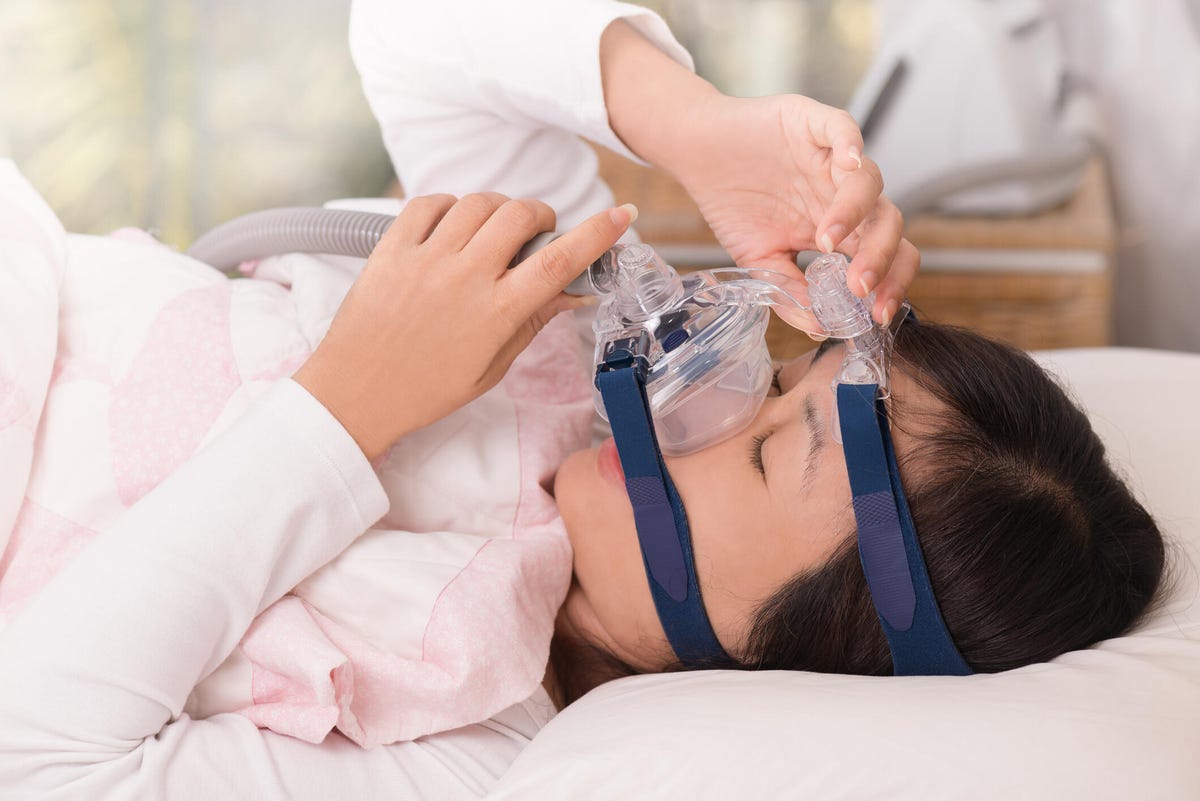These 5 tips make sleeping with a cpap machine easy to draw these 5 tips make sleeping with socks these 5 tips make sleeping with the devil these 5 tips make sleeping beauty these 5 tips make sleeping on the ground these 5 tips make sleeping mats these 5 tips makeup never eat these 5 foods harvard researchers say these 5 marry him right now if he has these 5 traits times like these 5 finger death punch youtube

These 5 Tips Make Sleeping With a CPAP Machine Easy
Sleeping with a CPAP machine can be annoying -- the mask covering your face, the hose tethering you to a machine that grumbles beside your bed. We get it. Undeniably, they can be a hassle, and that's a big reason why people opt to sleep without them. Up to 35% of people don't use their prescribed CPAP machine as intended. Some people only use it for a few hours each night, while others disregard it entirely.

We don't recommend doing that. Ignoring sleep apnea is serious as heart disease and high blood pressure. Instead of compromising your sleep quality and health, use these quick tips to make sleeping with a CPAP mask part of your routine.
1. Pick the right mask style
The good news is that CPAP machines have come a long way from the clunky old noise machine with a huge face mask. Newer models are very quiet, and there are various mask styles you can choose from. Modern CPAP machines offer mask variations that allow you to choose what works best for you.
Common CPAP mask styles:
- Full-face masks: This coverage option is what people expect from CPAP machines. It covers both your mouth and nose. It's a good option for people with nasal congestion or those who breathe through their mouths at night.
- Nasal mask: This mask only covers your nose. It's well suited for people who move around in their sleep.
- Nasal pillow mask: This mask has the smallest face covering -- it sits across your upper lip and nostrils. This option is great for people who feel claustrophobic in full coverage options or wear glasses.
- Oral mask: This mask covers only your mouth and is best suited for people who breathe out of their mouth at night.
Keep in mind what position you sleep in when choosing the style of mask. If you sleep on your stomach or side, the larger masks with various straps may push against your pillow.
2. Make sure your mask fits properly
Once you know which mask style best fits your needs, you must ensure it fits. An ill-fitting mask is uncomfortable and can leave you with a dry, stuffy nose. If you notice red marks on your face, it's too tight. On the other hand, you won't get the benefits CPAP machines offer if the mask is too loose.
Make adjustments each night until you find the perfect fit. When you adjust your mask, you should do so while lying down with the mask on your face. If you are having trouble getting your mask to fit properly, your doctor will be able to help you adjust the mask accordingly.

3. Practice wearing it during the day
When you first put on a CPAP mask, it can feel a bit like having a facehugger from Alien clamped to your face. It takes time to get used to. The last thing you want to do is save the adjustment period for when you are trying to fall asleep. Instead, start wearing it during the day so you get used to the sensation of being on your face. Wear it while you're watching TV or reading a book. Soon enough, you won't notice it at all.
If you find that you can't tolerate wearing it during the day, try breaking it down into steps. Start with just the mask -- no hose or straps. Then slowly attach the hose and straps to the process.
4. Use the 'ramp' feature
CPAP machines are designed to push air into your airways to keep them from collapsing from sleep apnea. For some people, the feeling of forced air is hard to tolerate, especially in the beginning. Many CPAP machines have a "ramp" feature that starts with lower air pressure as you fall asleep and increases through the night. Work with your doctor to find your prescribed optimal pressure for your sleep apnea.
5. Be patient
Getting used to sleeping with a CPAP machine is an ongoing process that you should measure in terms of small steps. No one brings home their brand-new CPAP machine and immediately sleeps eight uninterrupted hours with it on. CPAP machines can help you sleep better and ultimately improve your health in the long run. Despite the sometimes annoying CPAP struggles, you'll feel more rested if you sleep with it.
The information contained in this article is for educational and informational purposes only and is not intended as health or medical advice. Always consult a physician or other qualified health provider regarding any questions you may have about a medical condition or health objectives.
Source
Blog Archive
-
▼
2022
(176)
-
▼
October
(52)
- Asus ROG Phone 5 Has The Longest Battery Life Of A...
- 12 Of The Best Hidden WhatsApp Features You Need T...
- Honda SUV E Concept Previews Its Electric Future I...
- Stardew Valley Developer Announces New Game Haunte...
- Huawei's Mate 10 Pro Is Smart Enough To Drive A Po...
- RedMagic 7S Pro's Highlight Feature May Be Its Hid...
- Talkspace Online Therapy Review: Benefits, Cost An...
- Motorola Wants To Turn Your Edge Plus Into A WFH M...
- How To Fix Netflix Error Code M7111-5059 If You Ha...
- WWE WrestleMania 36 Day 1: Results, Insane Ending,...
- IPhone 13 Still Loses To Android Phones In Several...
- Oppo Find X5 Pro: Five Reasons This Flagship Andro...
- Honda And Sony Team Up To Build And Sell Electric ...
- Coordinated Phishing Attempts Targeted Election Of...
- Apple To Bring Live Captions And Other Accessibili...
- Best Laptops Of CES 2022
- Bezel-less Oppo R7 Leaks On Chinese Social Media
- Facebook Says It's Developing True AR Glasses
- Wordle: Our Simple 2-Step Strategy
- Facebook Parent Meta Battles Troll Farms, Hackers
- These 5 Tips Make Sleeping With A CPAP Machine Easy
- Samsung Galaxy S10 Plus Review: Killer Cameras And...
- Samsung's QD-OLED TV Might Be Here Very Soon. Here...
- Nissan Dealers Make Bank Steering Customers Into L...
- How To Choose The Best Webcam
- We Tried TCL's New Foldable Phone Concepts With Ro...
- Chris Rock Says He Turned Down 2023 Oscars Hosting...
- How To Buy A Laptop To Edit Photos, Videos Or For ...
- Look Like Hoth Stuff In This 'Star Wars' AT-AT Dri...
- Drones Set To Deliver Medical Products In Washingt...
- Use This Old Navy Flash Sale To Load Up On Fall Cl...
- Asus ROG Phone 3: Gaming On This Phone Makes Real ...
- Netflix Considers Livestreaming
- 360fly 4K Review: A Good 360 Action Cam Backed By ...
- Lenovo's New Legion Gaming Laptops Appear At CES, ...
- Google Has A Plan To Get You Accurate Midterm Elec...
- TCL Debuts The Cheapest Verizon High-speed 5G Phon...
- Stop Booking Your Flights On Fridays. This Is The ...
- All The Free PS4 And PS5 Games PlayStation Plus Su...
- AMD Nabs Apple Graphics Chip Designer
- How To Refinance Your Home
- More Than 11 Million Americans Could Still Benefit...
- If You're Streaming The Super Bowl, Expect To Lag ...
- 'House Of The Dragon' Episode 2 Recap: Succession ...
- New NASA Webb Space Telescope Data Has Astronomers...
- WhatsApp Messages From A 'prison' Island, Thousand...
- Oppo Sets N1 Swivel-cam Android Phone Price At $599
- Microsoft's Surface Laptop Studio Is $300 Off Toda...
- This Cheap Halloween Decoration Will Terrify Your ...
- Maserati Project24 Is A Track-Only MC20 With 740 HP
- Will Your IPhone Get IOS 16? Everything To Know
- 4moms Recalls Some MamaRoo Swings, RockaRoo Rocker...
-
▼
October
(52)
Total Pageviews
Search This Blog
Popular Posts
-
Resepi ayam goreng celup tepung bestari original, resepi ayam goreng celup tepung bestari kecil, resepi ayam goreng celup tepung bestari kot...
-
Underwriting for mortgage takes how long how long underwriting takes how long is underwriting for home loan how long for underwriting mortga...
-
What percentage of home sales fall through decline in home sales percentage of home sales that fall through when house sale falls through ho...
